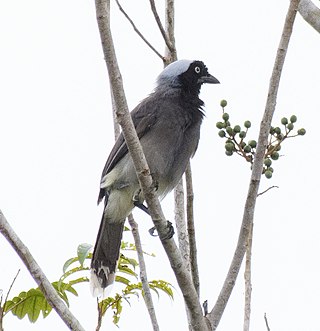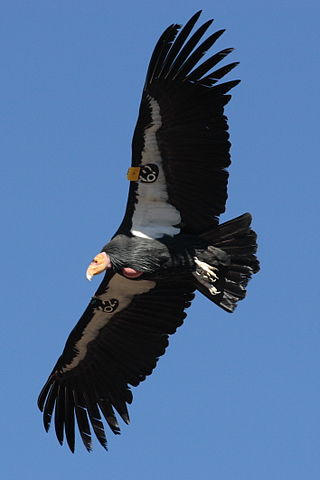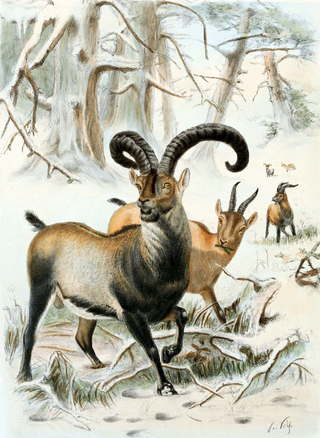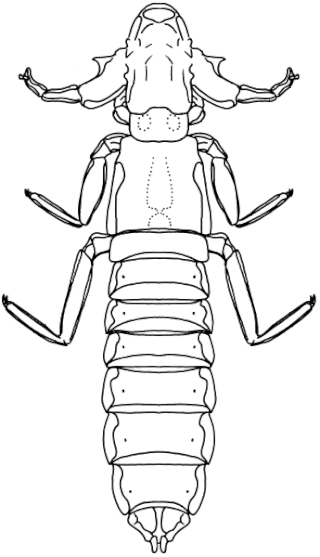
A lynx is any of the four extant species within the medium-sized wild cat genus Lynx. The name originated in Middle English via Latin from the Greek word lynx (λύγξ), derived from the Indo-European root leuk-, in reference to the luminescence of its reflective eyes.

The Eurasian lynx is one of the four extant species within the medium-sized wild cat genus Lynx. It is widely distributed from Northern, Central and Eastern Europe to Central Asia and Siberia, the Tibetan Plateau and the Himalayas. It inhabits temperate and boreal forests up to an elevation of 5,500 m (18,000 ft). Despite its wide distribution, it is threatened by habitat loss and fragmentation, poaching and depletion of prey.

The Iberian lynx is one of the four extant species within the medium-sized wild cat genus Lynx. It is endemic to the Iberian Peninsula in southwestern Europe. It is listed as Endangered on the IUCN Red List. In the 20th century, the Iberian lynx population had declined because of overhunting, poaching, fragmentation of suitable habitats, and the population decline of its main prey species, the European rabbit, caused by myxomatosis and rabbit haemorrhagic disease.

The laughing owl, also known as whēkau or the white-faced owl, is an extinct species of owl that was endemic to New Zealand. Plentiful when European settlers arrived in New Zealand, its scientific description was published in 1845, but it was largely or completely extinct by 1914. The species was traditionally considered to belong to the monotypic genus Sceloglaux Kaup, 1848, although recent genetic studies indicate that it belongs with the boobook owls in the genus Ninox.

The little spotted kiwi or little grey kiwi is a small flightless bird in the kiwi family, Apterygidae. It is the smallest of the five kiwi species, at about 0.9 to 1.9 kg, about the size of a bantam. It is endemic to New Zealand, and in pre-European times occurred in both main islands, but is now restricted to a number of small offshore islands, and mainland reserves protected by pest-exclusion fences. Little spotted kiwi was on the brink of extinction when a conservation effort took place 100 years ago. Five individuals were translocated from the South Island of New Zealand to Kapiti Island. Today, the Kapiti Island population has grown, with around 1200 birds.

The Spanish imperial eagle, also known as the Iberian imperial eagle, the Spanish eagle or Adalbert's eagle, is a species of eagle native to the Iberian Peninsula. The binomial commemorates Prince Adalbert of Bavaria. Due to its distinct "epaulettes", old literature often referred to this species as the white-shouldered eagle.

The Canary Islands oystercatcher, Canarian oystercatcher, or Canarian black oystercatcher , was a shorebird of uncertain taxonomy endemic to Fuerteventura, Lanzarote, and their offshore islets in the Canary Islands in Spain. It is now considered to be extinct.

The New Caledonian rail is a large and drab flightless rail endemic to the island of New Caledonia in the Pacific. It is considered Critically Endangered or possibly extinct.

Cabañeros National Park is a national park in the Montes de Toledo, Spain. It falls within two provinces, the northwest of Ciudad Real and the southwest of Toledo.

The azure-naped jay is a species of bird in the family Corvidae. It is found in Brazil, Colombia, and Venezuela.

A large proportion of living species on Earth live a parasitic way of life. Parasites have traditionally been seen as targets of eradication efforts, and they have often been overlooked in conservation efforts. In the case of parasites living in the wild – and thus harmless to humans and domesticated animals – this view is changing. The conservation biology of parasites is an emerging and interdisciplinary field that recognizes the integral role parasites play in ecosystems. Parasites are intricately woven into the fabric of ecological communities, with diverse species occupying a range of ecological niches and displaying complex relationships with their hosts.

De-extinction is the process of generating an organism that either resembles or is an extinct species. There are several ways to carry out the process of de-extinction. Cloning is the most widely proposed method, although genome editing and selective breeding have also been considered. Similar techniques have been applied to certain endangered species, in hopes to boost their genetic diversity. The only method of the three that would provide an animal with the same genetic identity is cloning. There are benefits and drawbacks to the process of de-extinction ranging from technological advancements to ethical issues.
Efforts to save endangered species may, paradoxically, lead to conservation-induced extinction of other species. This mostly threatens the parasite and pathogen species that are highly host-specific to critically endangered hosts. When the last individuals of a host species are captured for the purpose of captive breeding and reintroduction programs, they typically undergo anti-parasitic treatments to increase survival and reproductive success. This practice may unintentionally result in the extinction of the species antagonistic to the target species, such as certain parasites. It has been proposed that the parasites should be reintroduced to the endangered population. A few cases of conservation-induced extinction have occurred in parasitic lice.
The New Caledonian long-eared bat is a vesper bat found in New Caledonia. They are only recorded at Mount Koghis, near Nouméa, and the population is decreasing.

The Pyrenean ibex, Aragonese and Spanish common name bucardo, Basque common name bukardo, Catalan common name herc and French common name bouquetin, was one of the four subspecies of the Iberian ibex or Iberian wild goat, a species endemic to the Pyrenees. Pyrenean ibex were most common in the Cantabrian Mountains, Southern France, and the northern Pyrenees. This species was common during the Holocene and Upper Pleistocene, during which their morphology, primarily some skulls, of the Pyrenean ibex was found to be larger than other Capra subspecies in southwestern Europe from the same time.

Harrisoniella hopkinsi is a species of phtilopterid louse that lives on and eats the feathers of albatrosses. The species was first described by W. Eichler in 1952.
Colpocephalum californici, the California condor louse, is an extinct species of chewing louse which parasitized the California condor. In an example of coextinction, it became extinct when the remaining, Critically Endangered California condors were deloused and treated with pesticides during a captive breeding program.

Rallicola is a genus of chewing louse. It is an ectoparasite of rails and other birds. It was named by Thomas Harvey Johnston and Launcelot Harrison in 1911. There are two subgenera aside from the nominotypical subgenus: Aptericola, whose species are found on kiwi birds, and Huiacola, a monospecific subgenus consisting of Rallicola extinctus, once found on the huia.

Apterygon is a genus of louse. It is endemic to New Zealand and is an ectoparasite of kiwi birds (Apteryx). Theresa Clay circumscribed the genus in 1961. In 1947, she had referred to this genus as "New Genus D", but it was not formally named as she needed to confirm the host of her specimen as well as additional material.














